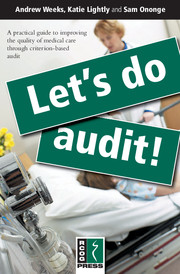 Let's Do Audit!
Let's Do Audit! Book contents
- Frontmatter
- Contents
- Acknowledgements
- Introduction
- Lesson 1 An introduction to clinical audit
- Lesson 2 Problem identification
- Lesson 3 Setting standards and establishing criteria
- Lesson 4 Measuring current practice
- Lesson 5 Analysing the data and comparing practice with agreed criteria
- Lesson 6 Implement change and re-audit
- Conclusion – let's do audit!
- References
- Appendix. Worked examples of audits
- Glossary of terms
- Index
Lesson 3 - Setting standards and establishing criteria
Published online by Cambridge University Press: 05 July 2014
- Frontmatter
- Contents
- Acknowledgements
- Introduction
- Lesson 1 An introduction to clinical audit
- Lesson 2 Problem identification
- Lesson 3 Setting standards and establishing criteria
- Lesson 4 Measuring current practice
- Lesson 5 Analysing the data and comparing practice with agreed criteria
- Lesson 6 Implement change and re-audit
- Conclusion – let's do audit!
- References
- Appendix. Worked examples of audits
- Glossary of terms
- Index
Summary
Central to any clinical audit and, in particular, criterion-based audit, is knowledge and recognition of the ‘standards of care’ for a particular condition. Once it is established exactly what should be done, then you can compare this with what is currently done and work out how to make improvements.
There are three simple steps to this part of the audit cycle: firstly you need to find reliable, up-to-date information about the subject. Then, using this information, you can define the audit criteria. The final step is deciding how frequently you should meet the criteria for the standard of care to be acceptable.
Criteria and standards
These two words – criteria and standards – have different meanings, which also can differ between different professional groups (note that ‘criteria’ is the plural of ’criterion’).
Audit criteria are explicit statements which define what is being measured; they represent elements of care that can be objectively measured. A criterion can be defined as a systematically developed statement that can be used to assess the appropriateness of specific healthcare decisions, services and outcomes. Criteria can also be classified into those concerned with:
■ structure (what is available)
■ process (what you do)
■ outcome of care (what the results are).
A standard is defined as ‘the level of care to be achieved for any particular criteria’.
- Type
- Chapter
- Information
- Let's Do Audit!A Practical Guide to Improving the Quality of Medical Care through Criterion-Based Audit, pp. 19 - 26Publisher: Cambridge University PressPrint publication year: 2010


